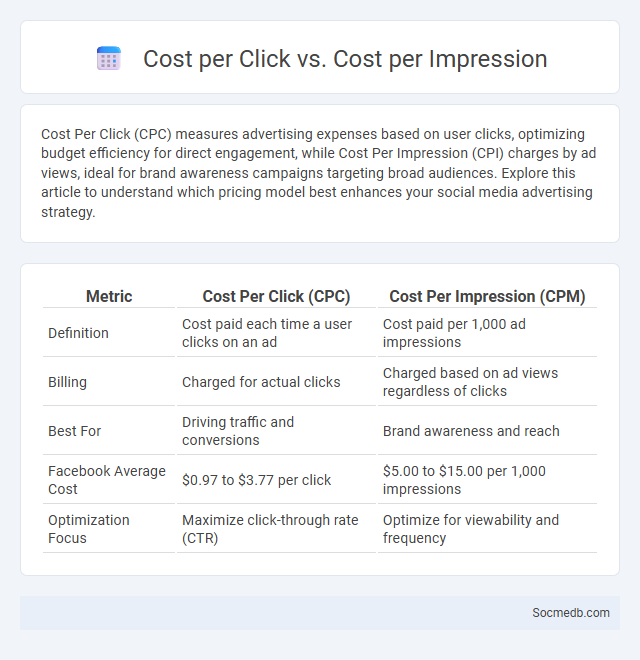
Photo illustration: Cost Per Click vs Cost Per Impression
Cost Per Click (CPC) measures advertising expenses based on user clicks, optimizing budget efficiency for direct engagement, while Cost Per Impression (CPI) charges by ad views, ideal for brand awareness campaigns targeting broad audiences. Explore this article to understand which pricing model best enhances your social media advertising strategy.
Table of Comparison
| Metric | Cost Per Click (CPC) | Cost Per Impression (CPM) |
|---|---|---|
| Definition | Cost paid each time a user clicks on an ad | Cost paid per 1,000 ad impressions |
| Billing | Charged for actual clicks | Charged based on ad views regardless of clicks |
| Best For | Driving traffic and conversions | Brand awareness and reach |
| Facebook Average Cost | $0.97 to $3.77 per click | $5.00 to $15.00 per 1,000 impressions |
| Optimization Focus | Maximize click-through rate (CTR) | Optimize for viewability and frequency |
Understanding Cost Per Click (CPC): Definition and How It Works
Cost Per Click (CPC) is a digital advertising metric that measures the amount you pay each time someone clicks on your social media ad, directly impacting your campaign budget and ROI. Platforms like Facebook, Instagram, and LinkedIn utilize CPC pricing models to charge advertisers only when users engage with their ads, ensuring cost-effective targeting. Understanding how CPC works enables you to optimize ad spend by balancing bid strategies, ad quality, and audience targeting for maximum engagement and conversions.
What Is Cost Per Impression (CPM)? Key Concepts Explained
Cost Per Impression (CPM) measures the cost advertisers pay for every 1,000 impressions of their ad on social media platforms. This metric helps you evaluate the efficiency of your advertising budget by tracking how many times your target audience sees your content. Understanding CPM allows you to optimize ad spend and maximize reach, ensuring your marketing efforts deliver maximum visibility.
Ad Auction Fundamentals: The Backbone of Online Advertising
Ad auction fundamentals are essential to online advertising, determining how ads are priced and displayed across social media platforms like Facebook and Instagram. These auctions use real-time bidding algorithms that evaluate factors such as bid amount, ad quality, and user relevance to deliver personalized content efficiently. Mastering these principles allows advertisers to maximize ROI by targeting specific audiences while optimizing budget allocation.
Comparing CPC and CPM: Pros, Cons, and Use Cases
Cost per click (CPC) advertising excels in driving direct user engagement and is ideal for campaigns aiming to boost website traffic or generate leads, while cost per mille (CPM) focuses on maximizing brand visibility by charging advertisers per thousand impressions, making it suitable for awareness campaigns. CPC offers precise control over ad spend and measurable ROI but can become costly in highly competitive markets, whereas CPM enables broader reach at a potentially lower cost but may result in less measurable user interaction. Marketers choose CPC for performance-driven goals and CPM for extensive audience exposure, balancing budget considerations with campaign objectives on platforms like Facebook Ads and Google Ads.
How Ad Auctions Determine Your Ad Placement and Cost
Ad auctions play a crucial role in determining your ad placement and cost on social media platforms by evaluating factors such as bid amount, ad quality, and user engagement predictions. These platforms use algorithms to assess the relevance and expected performance of your ad, ensuring ads that provide value to users get prioritized. Understanding how these auctions operate can help you optimize your bidding strategy and improve the effectiveness of your campaigns.
Factors Influencing CPC: Bids, Quality Score, and Competition
Cost Per Click (CPC) on social media platforms is primarily influenced by bid amounts, Quality Score, and level of competition. Higher bids increase the likelihood of ad placement, while Quality Score, derived from ad relevance, click-through rate, and landing page experience, enhances cost-efficiency. Intense competition raises CPC by driving up bid prices for popular audience segments and keywords.
How CPM Is Calculated: What Advertisers Need to Know
CPM, or Cost Per Mille, is calculated by dividing the total cost of an ad campaign by the number of impressions, then multiplying by 1,000. Advertisers need to understand that CPM directly reflects the expense for every thousand views, helping optimize budget allocation across platforms like Facebook, Instagram, or LinkedIn. Knowing your CPM allows you to measure ad efficiency and adjust targeting strategies to maximize return on investment.
Choosing Between CPC and CPM: Which Model Fits Your Goals?
Choosing between CPC (Cost Per Click) and CPM (Cost Per Mille) depends on your campaign objectives and budget. CPC is ideal for performance-driven campaigns aiming to maximize clicks and direct user engagement, while CPM suits brand awareness efforts targeting broad audience impressions. Analyzing key metrics like click-through rate, conversion rate, and cost efficiency helps determine which model aligns best with your social media marketing goals.
The Role of Ad Auction in CPC vs CPM Campaigns
The ad auction plays a crucial role in determining the cost-effectiveness of CPC (Cost Per Click) and CPM (Cost Per Mille) campaigns on social media platforms such as Facebook and Instagram. By evaluating bid amounts, ad relevance, and estimated action rates, the auction system prioritizes ads that optimize advertiser objectives, influencing whether advertisers pay per click or per thousand impressions. Understanding this mechanism enables marketers to strategically allocate budgets for maximum ROI, balancing cost efficiency with campaign engagement goals.
Maximizing ROI: Strategies for Efficient CPC, CPM, and Auction Performance
Maximizing ROI on social media requires precise management of cost-per-click (CPC), cost-per-mille (CPM), and auction dynamics to ensure efficient budget utilization. You can optimize campaign performance by leveraging real-time bidding strategies, audience segmentation, and continuous A/B testing to lower CPC and CPM while enhancing ad relevance and engagement. Monitoring auction trends and adjusting bids based on competitor activity helps maintain cost efficiency and improves your overall return on ad spend (ROAS).
 socmedb.com
socmedb.com